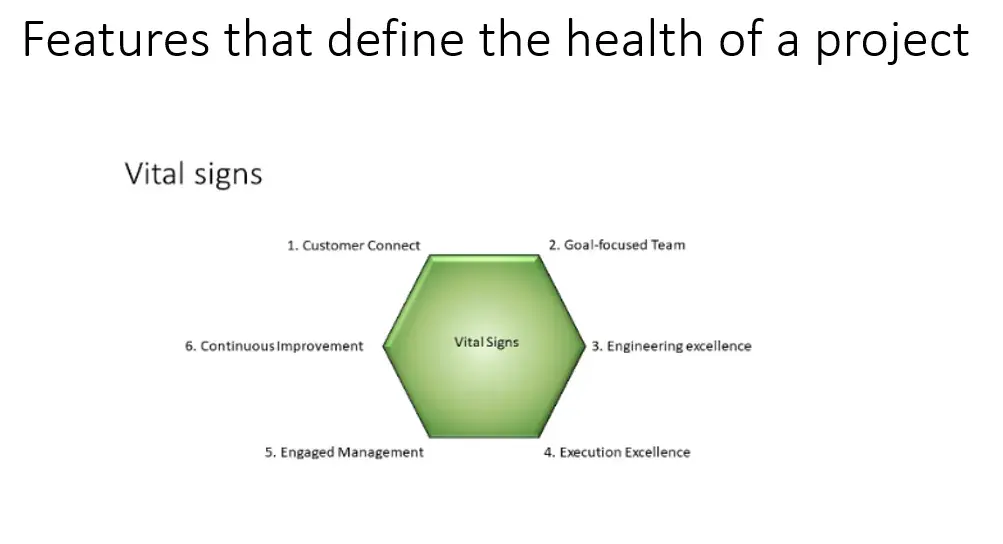Project status showed GREEN till yesterday and today it is all RED! Does this sound familiar?
Maybe, it has been RED for a while, but somehow, the RED did not become visible till now. And this often happens at the eleventh hour when fire-fighting is the only option left.
How do you assess the true status or health of a project? And how can you provide your customer of an assurance of positive outcomes during all stages of the project?
I had an occasion to talk to my colleague, Ananth, exactly about this. This is the third part of my discussions with Ananth.
Click here to see Part 1 of the discussions
Click here to see Part 2 of the discussions
Paramu
Ananth, I have a question on ‘Continuous Improvement’. Almost everybody claims do this! What is so important for this to be a vital sign?
Ananth
Often, people tick a few boxes to show that some metrics have improved over time – may be they did it by changing some review checklists or defect reduction, etc. But, the intent of this vital sign is to ensure that ‘pursuit of excellence’ is innate to the project and is a way of life throughout the project. All the stakeholders including the customer should play an active part in this improvement pursuit. Formalizing CI as a vital sign will ensure the right level of attention will be paid to this area.
Paramu
Ok, one thought struck me. We have talked mainly about development projects. What about maintenance and support projects? Could they use this framework?
Ananth
Most maintenance projects have software enhancements and periodic release schedules. They could certainly use this framework and it would be an ideal companion to their continuous improvement efforts.
This framework will be not useful for support projects which have key differences in execution and operational excellence.
Paramu
There is a lot of buzz about agile these days. Would this framework be useful?
Ananth
Yes – but let me qualify my statement. First of all, all the vital signs and most of the components would be meaningful for agile projects. There would be differences in the manifestations, though. Terminology in the framework is generic while agile teams would use specific terminology that is meaningful to them. In reality, many of the projects today seem to use a hybrid approach to agile adoption – more so with IT service providers. One key consideration: for agile teams external assessment or a review is not recommended. Teams themselves can use the framework via self-assessment. They can customize the framework for their needs and use it during a mid-release retrospective.
For classical short-duration agile projects with small teams, the framework is likely to be less useful.
Paramu
Interesting comment on self-assessment. I have often seen Project Managers and Teams resist external assessment and truth never comes out. How do we overcome this dynamics?
Ananth
Our recommendation is always for self-assessment – sponsored by the program manager or project manager with a genuine intent to improve. If it is to be done by someone external to the team, intent (for continuous improvement) should be clearly articulated to the teams and comparing with other projects should be avoided.
Paramu
Does the framework throw out a score like most Process Health Assessment tools?
Ananth
It unfortunately does! The intent of the score is only to get a broader picture of areas of focus. It is definitely not a measure to compare projects. If management does that, teams will focus on improving the score rather than the project!
Colour coding based on the score is another pit-fall. For example, the project that we illustrated earlier would have had an overall score of more than 90% but would be deep Red because of key weaknesses!
Paramu
That was an excellent discussion, Ananth. Hope our audience found it useful.
Ananth
Absolutely. Now tell us about the book, Paramu. I am very excited about it.

Paramu
Well, I found the framework so good for assessing project health that I thought it would be good to write a book on it and how it evolved. The book is with the publishers and should be coming out towards the end of June.
Ananth
I understand that you have adopted a unique style for the book.
Paramu
Yes. I have modelled the book along the lines of a story in an epic. Arjuna, the program manager of a large project, is very diffident and is not sure that he can deliver the program. His organisation then hires a coach, Krishna, to guide him through the project. The book talks of Arjuna’s journey of discovery of the vital signs and the framework. This gives him the confidence to go ahead with the program
Ananth
This is a great approach. I am sure people will find it interesting. I understand that it has been endorsed by some of the luminaries in the software world.
Paramu
Yes. Some of them are here.

Ananth
Great.
Paramu
Thank you, Ananth. It was great talking to you.




